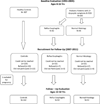Pediatric patients with dyspepsia have chronic symptoms, anxiety, and lower quality of life as adolescents and adults
- PMID: 22226783
- PMCID: PMC3321087
- DOI: 10.1053/j.gastro.2011.12.043
Pediatric patients with dyspepsia have chronic symptoms, anxiety, and lower quality of life as adolescents and adults
Abstract
Background & aims: Little is known about long-term health outcomes of children with dyspeptic symptoms. We studied the natural history of pediatric patients with dyspeptic symptoms, with and without histologic reflux, compared with healthy controls.
Methods: We performed a prospective study of consecutive new patients, ages 8-16 years, who underwent evaluation for dyspepsia, including upper endoscopy. Patients were assigned to groups with histologic evidence of reflux esophagitis (n = 50), or normal histology results (n = 53). Healthy children were followed up as controls (n = 143). Patients and controls were evaluated 5-15 years later. They provided self-reports on severity of dyspeptic symptoms, use of acid suppression, quality of life, anxiety, and depression.
Results: When the study began, the groups with histologic evidence of esophagitis and normal histologies did not differ in severity of dyspeptic symptoms, functional disability, or depression. After a mean 7.6-year follow-up period, each group had significantly lower quality-of-life scores and more severe dyspeptic symptoms and functional disability than controls, but did not differ significantly from each other; both groups were significantly more likely than controls to meet criteria for an anxiety disorder. At time of follow-up evaluation, use of acid-suppression medication was significantly greater in the group with histologic evidence for esophagitis, compared with patients who had normal histology findings when the study began.
Conclusions: Among pediatric patients with dyspepsia evaluated by endoscopy and biopsy, those with histologic evidence for esophagitis or normal histology findings are at increased risk for chronic dyspeptic symptoms, anxiety disorder, and reduced quality of life in adolescence and young adulthood.
Copyright © 2012 AGA Institute. Published by Elsevier Inc. All rights reserved.
Figures
References
-
- Sandler RS, Everhart JE, Donowitz M, et al. The Burden of Selected Digestive Diseases in the United States. Gastroenterology. 2002;122:1500–1511. - PubMed
-
- Pace F, Pallotta S, Vakil N. Gastroesophageal reflux disease is a progressive disease. Dig Liver Dis. 2007;39:409–414. - PubMed
-
- Agréus L, Svärdsudd K, Talley NJ, et al. Natural history of gastroesophageal reflux disease and functional abdominal disorders: a population-based study. Am J Gastroenterol. 2001;96:2905–2914. - PubMed
-
- El-Serag HB, Gilger M, Carter J, et al. Childhood GERD is a Risk Factor for GERD in Adolescents and Young Adults. Am J Gastroenterol. 2004;99:806–812. - PubMed
-
- Waring JP, Feiler MJ, Hunter JG, et al. Childhood Gastroesophageal Reflux Symptoms in Adult Patients. J Pediatr Gastroenterol Nutr. 2002;35:334–338. - PubMed



